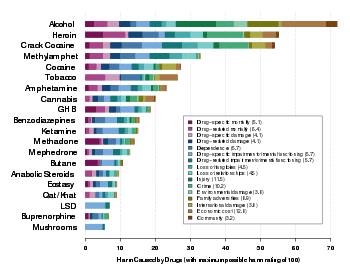Alcoholic hallucinosis
Alcoholic hallucinosis (or alcohol-related psychosis or alcohol-induced psychotic disorder) is a complication of alcohol misuse in people with alcohol use disorder.[1][2] Descriptions of the condition date back to at least 1907.[3] They can occur during acute intoxication or withdrawal with the potential of having delirium tremens. Alcohol hallucinosis is a rather uncommon alcohol-induced psychotic disorder almost exclusively seen in people with severe, recurrent alcohol use disorder (formerly known as chronic alcoholics) who have many consecutive years of severe and heavy drinking during their lifetime.[4] Alcoholic hallucinosis develops about 12 to 24 hours after the heavy drinking stops suddenly, and can last for days. It involves auditory and visual hallucinations, most commonly accusatory or threatening voices.[5] The risk of developing alcoholic hallucinosis is increased by long-term heavy alcohol abuse and the use of other drugs.[6]
| Alcoholic hallucinosis | |
|---|---|
| Specialty | Psychiatry |
Cause
The cause of alcoholic hallucinosis is unclear. It seems to be highly related to the presence of dopamine in the limbic system with the possibility of other systems.[7] There are many symptoms that could possibly occur before the hallucinations begin. Symptoms include headache, dizziness, irritability, insomnia, and indisposition. Typically, alcoholic hallucinosis has a sudden onset.[7]
Alcoholic hallucinosis vs. delirium tremens
Both alcoholic hallucinosis and DTs have been thought of as different manifestations of the same physiological process in the body during alcohol withdrawal.[8] Alcoholic hallucinosis is a much less serious diagnosis than delirium tremens. Delirium tremens (DTs) do not appear suddenly, unlike alcoholic hallucinosis. DTs also take approximately 48 to 72 hours to appear after the heavy drinking stops. A tremor develops in the hands and can also affect the head and body. A common symptom of delirium tremens is that people become severely uncoordinated. The biggest difference between alcoholic hallucinosis and delirium tremens is that alcoholic hallucinosis have a much better prognosis than DTs.[9] Moreover, delirium tremens can be fatal when untreated.[5]
Treatment
In general, alcohol abusers with withdrawal symptoms, such as alcoholic hallucinosis, have a deficiency of several vitamins and minerals and their bodies could cope with the withdrawal more easily by taking nutritional supplements. Alcohol abuse can create a deficiency of thiamine, magnesium, zinc, folate, and phosphate as well as cause low blood sugar.[10] However, several tested drugs have shown the disappearance of hallucinations. Neuroleptics and benzodiazepines showed normalization. Common benzodiazepines are chlordiazepoxide and lorazepam. It has been shown that management has been effective with a combination of abstinence from alcohol and the use of neuroleptics.[11] It is also possible to treat withdrawal before major symptoms start to happen in the body. Diazepam and chlordiazepoxide have proven to be effective in treating alcohol withdrawal symptoms such as alcoholic hallucinosis. With the help of these specific medications, the process of withdrawal is easier to go through, making alcoholic hallucinosis less likely to occur.[12]
See also
- Seeing pink elephants
- The Lost Weekend, a novel and Oscar winning film that includes a fictional portrayal of the illness
References
- Glass IB (January 1989). "Alcoholic hallucinosis: a psychiatric enigma--1. The development of an idea". Br J Addict. 84 (1): 29–41. doi:10.1111/j.1360-0443.1989.tb00549.x. PMID 2644996.
- Bayard M, McIntyre J, Hill KR, Woodside J (March 2004). "Alcohol withdrawal syndrome". Am Fam Physician. 69 (6): 1443–50. PMID 15053409.
- Emil Kraepelin; Allen Ross Diefendorf (1907). Clinical psychiatry; a text-book for students and physicians. Macmillan. pp. 189–. Retrieved 5 November 2010.
- Puri BK (2012). Textbook of Clinical Neuropsychiatry and Behavioral Neuroscience. Hodder Arnold.
- Alcohol Merck Manual, February 2003.
- Tsuang JW, Irwin MR, Smith TL, Schuckit MA (January 1994). "Characteristics of men with alcoholic hallucinosis". Addiction. 89 (1): 73–8. doi:10.1111/j.1360-0443.1994.tb00851.x. PMID 7755673.
- Galanter M, Kleber HD (2008). Textbook of Substance Abuse Treatment. American Psychiatric Publishing.
- Glass IB (1989). Alcohol hallucinosis: a psychiatric engima-1. The development of an idea.
- Glass IB (1989). Alcohol halucinosis: a psychiatric enigma-2. Follow-up studies.
- Alcohol-Withdrawal
- Soyka M, Täschner B, Clausius N (2007). "Neuroleptic Treatment of Alcohol Hallucinosis: Case Series". Pharmacopsychiatry. doi:10.1055/s-2007-992144.
- Pharmacologic Treatment of Withdrawal
External links
| Classification | |
|---|---|
| External resources |
